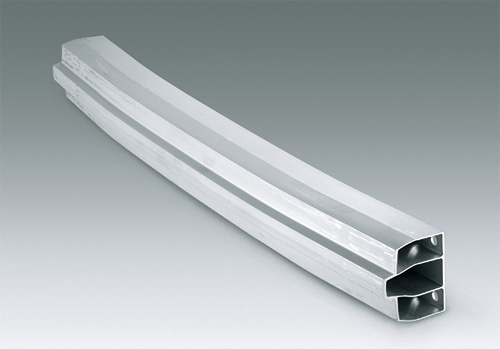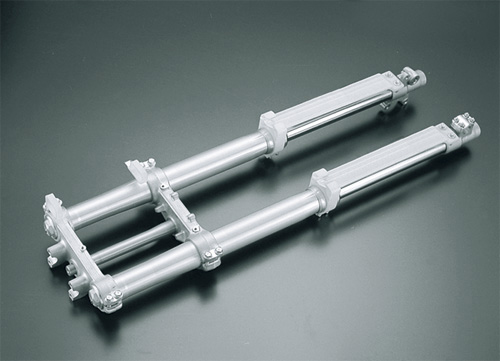High-Strength Aluminum Alloys for Structures: Extruded Shapes, Pipes & Bars
For bumpers and front forks


High-strength aluminum alloys, which are capable of creating complex extrusions. Applications include the outer material of bumper beams and front forks, and various types of piping. UACJ's lineup includes products with excellent fatigue strength and corrosion resistance, allowing customers to select the optimal product for their specific application.
Features
Extruded shapes- Aluminum alloy can be used to create complex cross-sectional shapes, thin-walled and multi-hole hollow materials.
- UACJ develops high-strength alloys for hollow extrusions with excellent bending workability.
- High-strength aluminum alloys can be applied to structural and rotational axis materials, enabling a significant reduction in weight.
- The optimal alloy can be selected from a comprehensive lineup of types to suit the specific application, such as for welded structures or precision cutting.
- Easy to work on a variety of components, by methods such as hot or cold forging, taper rolling, and joggling.
Types & Properties
Types and mechanical properties of high-strength aluminum alloys for structures
2000 Series
| Alloy series | Material properties | Mechanical properties | Properties | ||||
|---|---|---|---|---|---|---|---|
| AA-equivalent alloys*1 | Alloy | Temper | Tensile strength (N/mm2) |
Proof stress (N/mm2) |
Elongation (%) |
Hollow extrudability | |
| 2000 series | 2014 | 2014 | T4 | 420 | 285 | 20 | - |
| T6 | 480 | 410 | 13 | - | |||
| 2017 | 2017 | T4 | 440 | 275 | 22 | - | |
| 2024 | 2024 | T4 | 470 | 325 | 19 | - | |
| 2013 | 113S | T6 | 400 | 375 | 12 | 〇 | |
5000 Series
| Alloy series | Material properties | Mechanical properties | Properties | ||||
|---|---|---|---|---|---|---|---|
| AA-equivalent alloys*1 | Alloy | Temper | Tensile strength (N/mm2) |
Proof stress (N/mm2) |
Elongation (%) |
Hollow extrudability | |
| 5000 series | 5154 | 254S/5154 | O | 240 | 117 | 27 | - |
| 5083 | 5083 | O | 290 | 145 | 25 | - | |
6000 Series
| Alloy series | Material properties | Mechanical properties | Properties | ||||
|---|---|---|---|---|---|---|---|
| AA-equivalent alloys*1 | Alloy | Temper | Tensile strength (N/mm2) |
Proof stress (N/mm2) |
Elongation (%) |
Hollow extrudability | |
| 6000 series | 6005C | 6005C | T5 | 260 | 220 | 12 | 〇 |
| 6061 | 6061 | T6 | 315 | 275 | 19 | 〇 | |
| 6061 | 661S/CM61 | T6 | 340 | 300 | 18 | 〇 | |
| - | SG109 | T6 | 310 | 270 | 14 | 〇 | |
| - | SG310 | T6 | 400 | 365 | 18 | - | |
7000 Series
| Alloy series | Material properties | Mechanical properties | Properties | ||||
|---|---|---|---|---|---|---|---|
| AA-equivalent alloys*1 | Alloy | Temper | Tensile strength (N/mm2) |
Proof stress (N/mm2) |
Elongation (%) |
Hollow extrudability | |
| 7000 series | 7003 | 7003 | T5 | 310 | 260 | 16 | 〇 |
| 7204 | 7204 | T5 | 360 | 320 | 14 | 〇 | |
| 7204 | K70Y | T5 | 415 | 360 | 16 | 〇 | |
| - | ZK55 | T6 | 420 | 380 | 14 | 〇 | |
| 7046 | ZK170 | T6 | 450 | 420 | 14 | 〇 | |
| - | ZK80 | T6 | 500 | 470 | 14 | 〇 | |
| 7075 | 7075 | T6 | 590 | 540 | 14 | - | |
| 7050 | 7050/ZG62 | T6 | 620 | 570 | 13 | - | |
| - | ZC80 | T6 | 630 | 580 | 13 | - | |
| - | ZC88 | T6 | 650 | 600 | 13 | - | |
*1 AA: The Aluminum Association (U.S.A.)
Note: Stress corrosion cracking performance differs significantly depending on usage environment.
Please consult us separately for details.
Features of Representative Materials
Types and mechanical properties of high-strength aluminum alloys for structures (thickness: 1 mm)
- SG109
A high-strength 6000 series alloy, which has been mass-produced for use in bumpers - ZG62
Enjoys the leading global market share for use as the front fork outer material in motorbikes - ZK80
An alloy with enhanced high strength and high fracture toughness, achieved through structure control of 7204
Enables production of hollow shapes by means of porthole extrusion - ZC88
A high-strength, high-toughness alloy in the 7000 series of world-leading alloys
Also has excellent fatigue strength - 254S
A 5000 series non-heat-treated alloy for welded structural components, including subframes and instrument panel beams
Has good weldability and ample corrosion resistance in practical application

